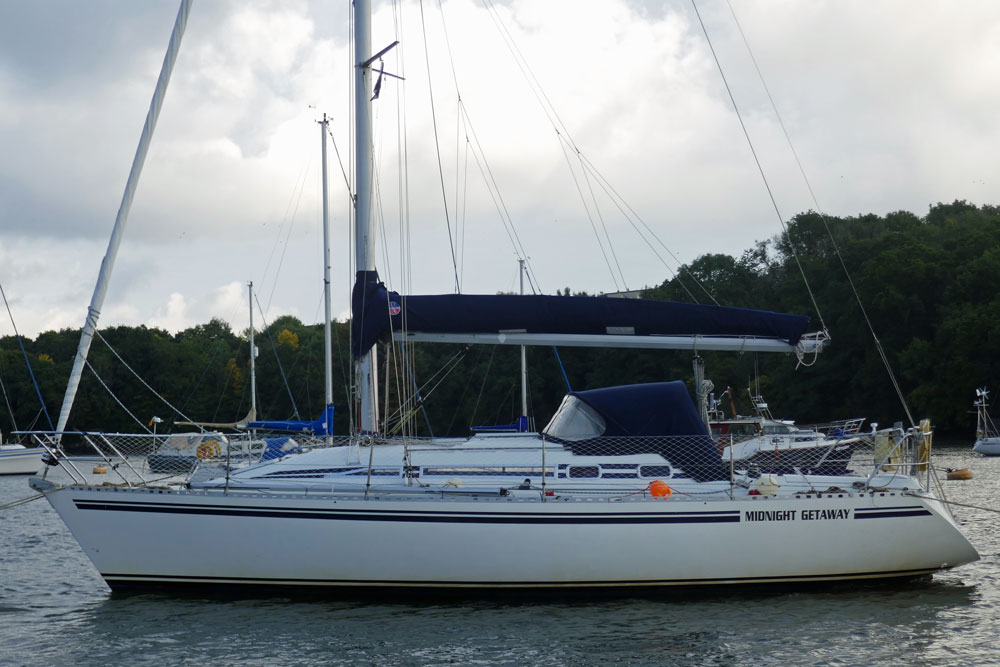- Home
- Cruising Yachts 30' to 35'
- MG 335
The MG 335 Sailboat
Specs & Key Performance Indicators
The MG 335, a light displacement fractionally rigged cruiser, was designed by Tony Castro and built in the UK by Northshore Yachts.
 An MG 335 Sailboat
An MG 335 SailboatPublished Specification for the MG 335
Underwater Profile: Fin keel & spade rudder
Hull Material: GRP (Fibreglass)
Length Overall: 34'9" (10.6m)
Waterline Length: 26'8" (8.4m)
Beam: 11'3" (3.4m)
Draft: 6'3" (1.9m)
Rig Type: Fractional sloop
Displacement: 8,900lb (4,037kg)
Ballast: 3,800lb (1,724kg)
Designer: Tony Castro
Builder: Northshore Yachts (UK)
Year First Built: 1986
Year Last Built: 1994
Published Design Ratios for the MG 335
Sail Area/Displacement Ratio: 20.0
Ballast/Displacement Ratio: 42.7
Displacement/Length Ratio: 188
Comfort Ratio: 18.4
Capsize Screening Formula: 2.2
Summary Analysis of the Design Ratios for the MG 335
1. A Sail Area/Displacement Ratio of 20.0 suggests that the MG 335 will, in the right conditions, approach her maximum hull speed readily and satisfy the sailing performance expectations of most cruising sailors.
2. A Ballast/Displacement Ratio of 42.7 means that the MG 335 will stand up well to her canvas in a blow, helping her to power through the waves.
3. A Displacement/Length Ratio of 188, tells us the MG 335 is clearly a light displacement sailboat. If she's loaded with too much heavy cruising gear her performance will suffer to a degree.
4. Ted Brewer's Comfort Ratio of 18.4 suggests that the MG 335 will have the motion underway to that of a lightweight racing boat. Crew comfort will often be memorable for all the wrong reasons. Beating upwind in lively conditions the xxxxx will slam enough to shake your fillings out with a motion that most cruising sailors have no desire to get used to.
5. The Capsize Screening Formula of 2.2 tells us that a MG 335 would not be as good a choice of sailboat for ocean passage-making, owing to the increased risk of capsize in strong winds and heavy seas when compared to a sailboat with a CSF of less than 2.0.
The MG 335: A Versatile and Fun Sailboat for Recreational Sailors
The MG 335 was designed by Tony Castro and has a fractional sloop rig, a spade rudder and a fixed fin keel. It has a PHRF racing average handicap of 138 with a high of 138 and low of 138 and a hull speed of 7.05 knots.
Accommodation
The MG 335 has a spacious, comfortable interior that accommodates up to six people. The layout consists of a V-berth forward cabin, a saloon with a U-shaped settee and a folding table to starboard and a single settee to port, a galley to port aft of the saloon, a navigation station to starboard opposite the galley, a head compartment with shower to starboard aft of the navigation station, and an aft cabin with a double berth to port. The saloon also has two pilot berths above the settees for extra sleeping space. The interior is finished in teak veneer with white headlining and upholstery.
The galley is well-equipped with a two-burner stove with an oven, a stainless steel sink with hot and cold water, a top-loading refrigerator, and ample storage space. The navigation station has a large chart table with an instrument panel and electrical switches. The head compartment has a marine toilet, a washbasin, and a shower with an electric pump. The aft cabin has a hanging locker, shelves, and an opening portlight. The V-berth cabin has storage lockers, shelves, and an opening hatch.
Hull and Deck
The hull of the MG 335 is made of a hand-laid glassfibre with a balsa core above the waterline and solid laminate below. The hull-deck joint is covered by an aluminum toe rail. The hull shape is moderate with a fine entry, flared topsides, rounded bilges, and flat sections aft. The deck layout is simple and functional with wide side decks, molded non-skid surfaces, stainless steel stanchions and lifelines, bow and stern pulpits, mooring cleats, anchor locker, bow roller, chainplates on the hull sides, cockpit coamings with winch pockets, cockpit locker lids with gas struts, transom ladder, sugar scoop stern with swim platform, tiller steering or optional wheel steering in an aft cockpit or center cockpit configuration.
Mast and Rigging
The mast of the MG 335 is made of aluminum alloy and is deck-stepped on a compression post. The boom is also made of aluminum alloy and has internal reefing lines. The rigging is stainless-steel wire with swaged terminals. The sail area is 535.83 sq ft (49.780 m2) with a mainsail of 307.5 sq ft (28.6 m2) and a 100% foretriangle of 228.3 sq ft (21.2 m2). The sails are controlled by two self-tailing primary winches, two self-tailing halyard winches, and a self-tailing mainsheet winch on the cabin top. The running rigging is mostly led aft to the cockpit through clutches and organizers.
This article was written with the assistance of Gemini, a large language model developed by Google. Gemini was used to gather information, summarize research findings, and provide suggestions for the content and structure of the article.
Recent Articles
-
Is An SSB Marine Radio Installation Worth Having on Your Sailboat?
Apr 14, 25 02:31 PM
SSB marine radio is expensive to buy and install, but remains the bluewater sailors' favourite means of long-range communication, and here's why -
Correct VHF Radio Procedure: Your Questions Answered
Apr 14, 25 08:37 AM
Got a question about correct VHF radio procedure? Odds are you'll find your answer here... -
VHF Marine Radio; Which One is Right for Your Boat?
Apr 14, 25 05:09 AM
If you're looking to buy a VHF Marine Radio the choice can be a bit overwhelming. So what should it be, a fixed VHF or a handheld VHF? Maybe one with AIS or GPS built in perhaps?













